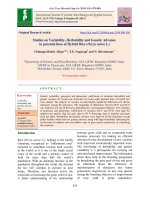Variability, heritability and genetic advance studies in advanced genotypes of rice (Oryza sativa L.)
Bạn đang xem bản rút gọn của tài liệu. Xem và tải ngay bản đầy đủ của tài liệu tại đây (126.11 KB, 3 trang )
����������������������������������������������������������������������������������������������������������������������������������������������������������������������������������������������������������������������������������������������������������������������������������������������������������������������������������������������������������������������������������������������������������������������������������������������������������������������������������������������������������������������������������������������������������������������������������������������������������������������������������������������������������������������������������������������������������������������������������������������������������������������������������������������������������������������������������������������������������������������������������������������������������������������������������������������������������������������������������������������������������������������������������������������������������������������������������������������������������������������������������������������������������������������������������������������������������������������������������������������������������������������������������������������������������������������������������������������������������������������������������������������������������������������������������������������������������������������������������������������������������������������������������������������������������������������������������������������������������������������������������������������������������������������������������������������������������������������������������������������������������������������������������������������������������������������������������������������������������������������������������������������������������������������������������������������������������������������������������������������������������������������������������������������������������������������������������������������������������������������������������������������������������������������������������������������������������������������������������������������������������������������������������������������������������������������������������������������������������������������������������������������������������������������������������������������������������������������������������������������������������������������������������������������������������������������������������������������������������������������������������������������������������������������������������������������������������������������������������������������������������������������������������������������������������������������������������������������������������������������������������������������������������������������������������������������������������������������������������������������������������������������������������������������������������������������������������������������������������������������������������������������������������������������������������������������������������������������������������������������������������������������������������������������������������������������������������������������������������������������������������������������������������������������������������������������������������������������������������������������������������������������������������������������������������������������������������������������������������������������������������������������������������������������������������������������������������������������������������������������������������������������������������������������������������������������������������������������������������������������������������������������������������������������������������������������������������������������������������������������������������������������������������������������������������������������������������������������������������������������������������������������������������������������������������������������������������������������������������������������������������������ny plant breeder to work with crop
improvement
programs.
The
present
investigation was under taken in this context to
elucidate information on variability, heritability,
genetic advance, character associations and path
of effect in promising rice genotypes. A good
knowledge of genetic resources might also help
in identifying desirable genotypes for future
hybridization program.
Materials and Methods
The experiment was carried out during kharif,
2018 at Agricultural and Horticultural
Research
station,
kathalagere
under
University of Agricultural and Horticultural
Sciences, Shivamogga, Karnataka. The
material comprised of thirty five advanced
rice genotypes own in a randomized complete
block design with two replications with
spacing of 20 X 15 cm. Data were recorded
on five randomly selected plants in each entry
in each replications for the traits days to 50%
flowering, Plant height (cm), Productive
tillers/m2 and Yield kg/ha. The data subjected
to INDOSTAT software to estimate Genetic
coefficient of variation (%), phenotypic
coefficient of variation (%), Heritability (%)
(Broad sense), Genetic Advance and Genetic
Advance as percent of mean. The estimates
for variability treated as per the categorization
proposed by Siva Subramanian and
Madhavamenon (4), heritability and genetic
advance as percent of mean estimates
according to criteria proposed by Johnson et
al., (2).
Results and Discussion
In the present study analysis of variance
revealed the existence of significant
differences among genotypes for all traits
studied. The mean, variability estimates i.e.,
Genetic coefficient of variation (%),
phenotypic coefficient of variation (%),
Heritability (%) (Broad sense), Genetic
Advance as percent of mean are presented in
table 1. All traits under studied have higher
phenotypic coefficient of variation than
genotypic coefficient of variation. The
magnitude of phenotypic coefficient of
variation and genotypic coefficient of
variation was moderate to high for the traits
panicles per square metre and yield (3, 5).
The high PCV observed for yield per hectare
(5).
1669
Int.J.Curr.Microbiol.App.Sci (2020) 9(8): 1668-1670
Table.1 Variability, heritability and genetic advance for quantitative traits in rice
Character
Mean
Phenotypic
coefficient of
variation (%)
11.04
Heritability
(%)
Genetic
advance (%)
117
Genetic
coefficient of
variation (%)
9.90
0.98
25.88
Genetic
advance as
percent mean
21.46
Days to fifty percent
flowering
Plant height(cm)
Panicles per m2
Yield kg/ha
76
389
3558
17.78
22.05
30.6
17.40
20.65
30.36
0.93
0.80
0.95
23.18
155.00
2258.00
33.44
34.66
53.54
The high GCV obtained for number of
panicles per square metre indicating the
improvement is possible through selection.
Genotypic coefficient of variation measures
the extent of genetic variability percent for a
trait but does not assess the amount of genetic
variation which is heritable. Heritability
estimates were high for all the characters.
The heritability estimates along with genetic
advance can be useful to predict effect of
selection in selection programmes. The traits
like days to fifty percent flowering, yield (7)
and plant height exhibited high magnitude of
genetic advance as percent of mean.
The traits plant height, days to fifty percent
flowering, panicles per square metre and yield
have high heritability along with genetic
advance as percent of mean indicate that these
characters attributable to additive gene effects
which are fixable revealing that improvement
in these characters would be possible through
direct selection.
2.
3.
4.
5.
6.
7.
References
1. Genetic variability and association analysis
in rice. International Journal of Applied
Biology and Pharmaceutical Technology.
5(2): 63-65.
Johnson, H.W. Robinson, H.F. and
Costock, R.E., Estimates of genetic and
environmental variability in Soyabean.
Agronomy Journal, 47(7): 314-318 (1955)
Roy, B. Hossain, M. and Hossain, F.,
Genetic variability in yield components of
rice (Oryza sativa L.). Environment and
Ecology. 19(1): 186-189 (2001).
Siva Subramanian, S. and madhavamenon,
P., Combining ability in rice. Madras
Agricultural Journal. 60: 419-421 (1973)
ThirumalaRao, V. Chandra Mohan, Y.
Bhadru, D. Bharathi, D. and Venkanna,. V.
(2014).
Venkanna, V., Lingaiah, N., Raju, Ch and
Rao, V.T., Genetic studies for quality traits
of F1population of rice (Oryzasativa L.).
International Journal of Applied Biology
and PharmaceuticalTechnology. 5(2): 125127 (2014)
Vaithiyalingan, M. and Nadarajan, N.,
Genetic variability, heritability and genetic
advance in F population of inter subspecific crosses of rice. Crop Research.
31(3): 476-477 (2006).
How to cite this article:
Manjunatha, B., Nagaraja Kusagur and Niranjanja Kumara, B. 2020. Variability, Heritability
and Genetic Advance Studies in Advanced Genotypes of Rice (Oryza sativa L.).
Int.J.Curr.Microbiol.App.Sci. 9(08): 1668-1670. doi: />
1670
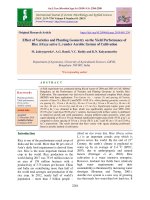
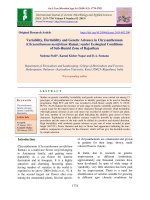
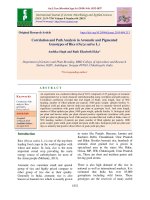
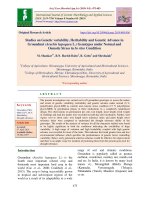
![Studies on genetic variability, heritability and genetic advance in F2 segregating population of Cross Arka Archana × AAC-1 in China Aster [Callistephus chinensis (L.) Nees]](https://media.store123doc.com/images/document/2020_01/14/medium_pyb1578991636.jpg)
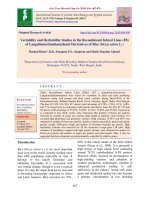

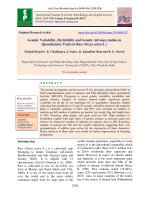
![Studies on genetic variability, heritability and genetic advance in F4 population of china aster [Callistephus chinensis L. (Nees.)]](https://media.store123doc.com/images/document/2020_03/02/medium_mqh1583125904.jpg)
